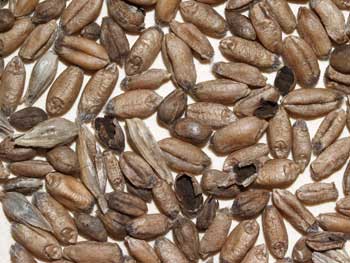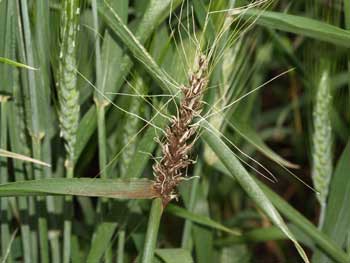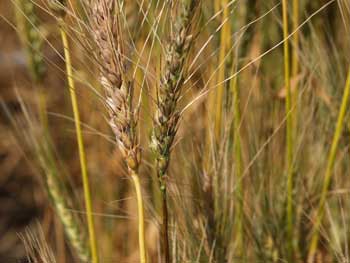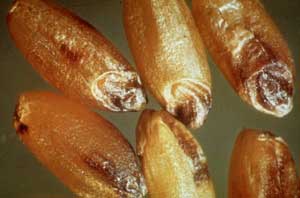Fargo, North Dakota
July 28, 2006
Source:
Crop Watch News Service
University of Nebraska-Lincoln
Extension, Institute of Agriculture and Natural Resources
http://cropwatch.unl.edu/archives/2006/Crop18/wheat.htm
 |
|
Figure 1. Wheat grains
containing spore masses of stinking smut. |
 |
|
Figure 2. Loose smut on a
wheat head.. |
 |
|
Figure 3. Wheat grain
contaminated with ergots. |
 |
|
Figure 4. Wheat heads
infected by Fusarium head blight (left) and black chaff
(right). |
 |
|
Figure 5. Wheat grain discolored at the
embryo region by black point.
(Photo credit: John E.
Watkins) |
This year there have been reports of wheat
with stinking smut in several counties in southern Nebraska.
Stinking smut, also known as common bunt, derives its name from
a strong fishy odor associated with infected wheat kernels (Figure
1). It is caused by two closely
related fungi whose spores contaminate grain during harvest.
Stinking
smut is one of several seed transmitted fungal diseases of
wheat. Other diseases include loose smut (Figure
2), ergot (Figure
3), Fusarium head blight or scab (Figure
4) and black point (Figure
5). Black chaff (Figure 4), a bacterial disease, is
also seed transmitted.
Economic importance of seed transmitted diseases
Seed-transmitted diseases reduce yields as well as grain
quality. Grain contaminated by stinking smut can be rejected at
the elevator, often resulting in total loss. The pungent odor
associated with contaminated grain causes livestock to reject
it, significantly reducing its value as a feed. In addition, the
compound responsible for the odor, trymethylamine, has potential
to cause explosions in combines and elevators when present in
appropriate concentrations.
Although
loose smut does not affect grain quality, yield losses of up to
40% can result from the disease.
Incidence of ergot in wheat is relatively low; however,
sclerotia or ergots (compact masses of the ergot fungus) can
lower grain quality. In addition, the ergots contain toxic
alkaloids that can cause ergotism and death in humans and
livestock.
If seed
heavily contaminated with Fusararium head blight fungi is sown,
seedling emergence can be reduced by up to 80%. Significant
yield losses also can result from floret sterility and poor seed
filling. More importantly, the Fusarium species that cause head
blight produce mycotoxins that can contaminate grain, causing it
to be less palatable to livestock. If contaminated grain is used
as feed or in food products, the mycotoxins can cause health
problems in both livestock and humans.
Black
point can significantly reduce the bread-making quality of
wheat. Heavy contamination of grain with black point can result
in discolored flour. Millers can reject grain on this basis.
Black
chaff can cause up to 40% reduction in yield. Germination of
seed that is severely infected by the black chaff bacterium can
be significantly reduced.
Management of seed transmitted diseases
Three
strategies can be used in combination to manage seed-transmitted
diseases of wheat: seed treatments, use of clean seed and
planting resistant varieties.
Using seed treatments
Seed
treatments are important for several reasons.
- They
control seed transmitted pathogens that may be surface-borne
on the seed or internally seed-borne. Additionally, they
control soil-borne pathogens such as Pythium and Rhizoctonia
that cause seedling damping off and root and crown rots.
Systemic seed treatments also provide additional protection
against fall season foliar diseases.
- In
addition to controlling diseases, fungicide-insecticide
combination seed treatments also control insect pests such
as wireworms, Hessian fly, and fall season aphids.
- By
controlling seedling damping off, seed treatments improve
stand establishment and result in healthy, vigorous
seedlings. Such seedlings build natural defenses that
provide additional protection from disease and insect pests.
It is
preferable to buy certified treated seed or have it cleaned and
treated by a commercial seed conditioner. If seed is treated
on-farm, it is essential to clean it first before treating.
Cleaning seed before treating is especially necessary if the
seed transmitted diseases listed above were present in the field
during the growing season. For the seed treatment to be
effective, ensure thorough, uniform coverage. If possible, use a
broad spectrum systemic fungicide or fungicide-insecticide
combination product. For a list of seed treatment fungicides for
control of seed transmitted diseases of wheat, see the UNL
Extension NebFact,
Wheat Disease Fact Sheet No. 6: Management Program to
PreventSmut Diseases of Wheat (NF03-587). A more
comprehensive list of seed treatment products for control of
diseases and insect pests of wheat can be found at the
Nebraska Department of Agriculture Pesticide Registrations Web
site.
Fungicide seed treatments are
not effective against ergot and black chaff. The best strategy
for managing these diseases is using certified, pathogen-free
seed.
For more information see the
UNL Extension Circulcar,
Diseases Affecting Grain and Seed Quality in Wheat (EC97-1874)
Planting resistant
varieties
Resistant varieties can be used
in combination with seed cleaning and seed treatments to more
effectively manage seed transmitted diseases of wheat. The
Wheat Varieties Virtual Tour Web site lists the wheat
varieties grown in Nebraska and information on each variety,
including disease resistance and susceptibility. It also
contains information on how to select wheat varieties adapted to
your area. Another useful resource is the Nebraska Crop
Improvement Association's online
Seed Book.
Using clean/certified,
treated seed
The importance of using
clean/certified, treated seed cannot be overemphasized.
Clean/certified, treated seed optimizes the chances of obtaining
high yields. Using farmer-saved or bin-run seed is likely to
result in poor variety purity, a low germination percentage,
poor stand establishment, and disease, insect, and weed
problems. The result will be reduced yield and poor grain
quality. Total loss may result if grain is heavily contaminated
with fungal spores. Additional costs may be incurred in treating
for diseases, insects, and weeds resulting from use of poor
quality seed. In terms of dollars, the return from using
clean/certified, treated seed will almost always exceed the cost
of the seed. Using clean/certified, treated seed is a form of
insurance that is definitely worth the cost.
Stephen Wegulo
Extension Plant Pathologist, Lincoln
Source:
Crop Watch News Service
University of Nebraska-Lincoln
Extension, Institute of Agriculture and Natural Resources
http://cropwatch.unl.edu/archives/2006/Crop18/wheat.htm
|